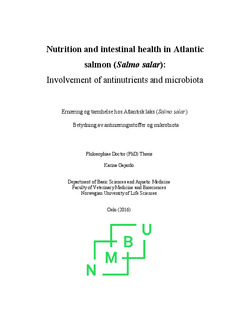| dc.contributor.advisor | Krogdahl, Åshild | |
| dc.contributor.advisor | Bakke, Anne Marie | |
| dc.contributor.advisor | Kortner, Trond M. | |
| dc.contributor.advisor | Sørum, Henning | |
| dc.contributor.author | Gajardo, Karina | |
| dc.date.accessioned | 2017-07-04T14:19:39Z | |
| dc.date.available | 2017-07-04T14:19:39Z | |
| dc.date.issued | 2016 | |
| dc.identifier.isbn | 978-82-575-1981-0 | |
| dc.identifier.issn | 1894-6402 | |
| dc.identifier.uri | http://hdl.handle.net/11250/2447796 | |
| dc.description.abstract | The use of alternative protein ingredients to replace fishmeal in diets for Atlantic salmon (Salmo salar) can have negative consequences for the fish intestinal health. The most severe intestinal physiological and morphological effects were first observed to be induced in the distal intestine (DI) by soybean meal and called soybean meal induced enteritis (SMBIE). Other intestinal health disorders suggested to be related to the increasing use of plant ingredients in the diets include lipid malabsorption syndrome and intestinal tumors. SBMIE has been linked to the presence of antinutritional factors (ANFs) in soybean meal, which are also present in other legumes. Among the ANFs, saponins − alone or in combination with other ANFs − have been suggested as the most plausible cause of SBMIE and other legume-induced enteropathies. The syndrome seems to vary with stage of fish development, breed of soybeans and possibly other biotic, as well as abiotic conditions. Among other intestinal conditions that might influence the severity of SBMIE is the intestinal microbiota, for which present knowledge is very limited both in general and in their potential involvement in enteric pathologies in the salmon intestine.
The work presented in this thesis contributes to the basic knowledge regarding the effects of saponins and intestinal microbiota necessary for the understanding of the normal intestinal health of Atlantic salmon and the consequences of increasing use of alternative protein ingredients as replacement to fishmeal in the diet. Three aims were formulated;
Aim 1: to find the important the mechanisms behind effects of soya saponins on the intestinal function and their role in SBMIE,
Aim 2: to characterize the digesta- and mucosa-associated microbiota along the intestine of Atlantic salmon fed a commercial diet, and
Aim 3: to characterize the effect on intestinal microbiota caused by the inclusion of alternative protein sources in the diet of Atlantic salmon and the microbiota’s role for the function and health of the intestine. | nb_NO |
| dc.description.abstract | Bruk av alternative proteinkilder som erstatning for fiskemel i fôr til atlantisk laks (Salmo salar) kan medføre redusert tarmhelse. De første tegn på fysiologiske og morfologisk helseeffekter i tarmen, ble observert i den distale delen av tarmen (DI), og var indusert av innblanding av soyamel i fôret. Symptombildet ble kalt soyaindusert enteritt (SBMIE). Laksens tarm er grundig studert når det gjelder slike negative effekter av proteinrike alternative fôrmidler. Blant øvrige effekter på tarmhelse som kan ha sammenheng med den økte broken av planteingredienser i fôret er en tilstand som er beskrevet som lipidmalabsorpsjonssyndrom, og en annen som fører til
tarmsvulst. Soyaindusert enteritt ser ut til å ha sammenheng med innholdet av antinæringsstoffer (ANFs) og er vist å kunne induseres også av frø fra andre belgvekster. Blant de aktuelle ANFs i soyamel ser saponinene, alene eller i samvirke med andre antinæringsstoffer, ut til å være de mest sentrale for utviklingen av SBMIE. Symptomene kan variere med fiskens utviklingsstadium,
sorten soya som brukes, og muligens med andre biotiske og abiotiske forhold. Blant andre tarmforhold som kan være av betydning for alvorlighetsgraden av SBMIE, er sammensetningen av microbiota som vi har svært lite relevant kunnskap om både generelt og når det gjelder den rolle den spiller for patologiske tilstander hos laks. Arbeidet som presenteres i denne avhandlingen bidrar med grunnleggende kunnskaper om virkninger av saponiner og om tarmens mikrobiota. Denne kunnskapen er nødvendig for forståelsen av normal tarmfunksjon hos laks og virkninger på tarmhelsen av økt bruk av alternative proteinfôrmidler som erstatning for fiskemel. Tre mål ble formulert for arbeidet;
Mål 1: å finne de viktige mekanismene bak effektene av soyasaponiner på tarmfunksjon og rollen de spiller for utviklingen av SBMIE,
Mål 2: å beskrive tarmens mikrobiota, både den som finnes i tarminnholdet og den som er forankret i mukosa langs hele tarmkanalen hos laks som spiser et kommersielt fôr,
Mål 3: å beskrive effekter på tarmens microbiota av ulike proteinkilder i fôret til laks og rollen mikrobiotaen spiller for tarmens funksjon og helse. | nb_NO |
| dc.language.iso | eng | nb_NO |
| dc.publisher | Norwegian University of Life Sciences, Ås | nb_NO |
| dc.relation.ispartofseries | PhD Thesis;2016:88 | |
| dc.rights | Attribution-NonCommercial-NoDerivatives 4.0 Internasjonal | * |
| dc.rights.uri | http://creativecommons.org/licenses/by-nc-nd/4.0/deed.no | * |
| dc.title | Nutrition and intestinal health in Atlantic salmon (Salmo salar) : involvement of antinutrients and microbiota | nb_NO |
| dc.title.alternative | Ernæring og tarmhelse hos atlantisk laks (Salmo salar) : betydning av antinæringsstoffer og mikrobiota | nb_NO |
| dc.type | Doctoral thesis | nb_NO |
| dc.source.pagenumber | 1 b. (flere pag.) | nb_NO |

